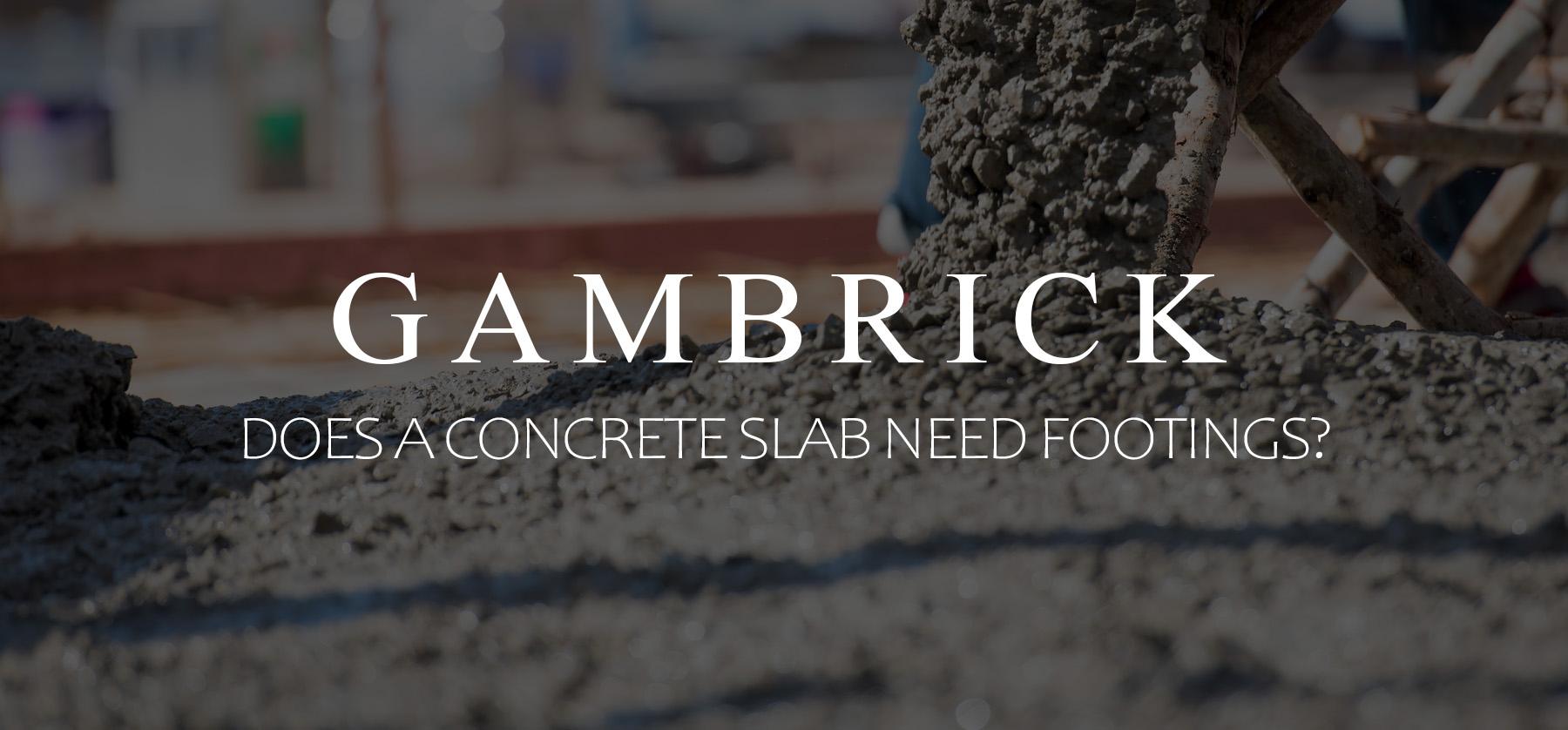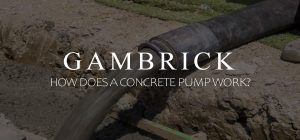
Does A Concrete Slab Need Footings?
A concrete slab doesn’t typically need footings if it’s a patio, driveway or sidewalk slab. However, if the slab is structural, such as a foundation slab, it needs a footing. Modern homes require footings under all load bearing walls, columns and support structures to carry the weight above. Footings sit directly under the slab along the entire perimeter and beneath all load points. Typically, slab foundation footings are at least 3 foot deep or beneath the frost line to prevent heaving caused by the freeze/thaw cycle.
A concrete slab foundation requires footings for the following reasons:
- Help prevent water from seeping beneath the slab.
- Provide support for all load bearing members.
- Help the slab resist cracking and settling.
- Resist heaving and shifting caused by the freeze/thaw cycles.
- Prevent animals from burrowing under the slab.
- Provide a heavy anchor point for structures which helps in high winds and earthquakes.
Modern concrete slab foundations require footings reinforced with rebar. Any structure built on top the slab is then bolted down to the footings with anchor bolts. This helps create a very strong and stable foundation and structure.
Many older homes built on a slab did not have footings. They only have a concrete slab and may or may not have a small trench of concrete beneath along perimeter. This type of construction was common for small ranches and shacks and is no longer legal.
Small structures, like sheds, can typically be built on a concrete slab without footings. The weight of a concrete slab is often enough to support a lightweight structure all by itself if it’s leveled properly.
Types Of Concrete Slabs With Footings
There are types of concrete slab foundation with footings. A typical slab with footings, a floating slab and a monolithic slab.
- Typical Slab With Footings: A typical slab with footings is the most common type used in construction. A footing is a large area of concrete poured below grade that acts as the base of the home’s foundation. The slab is poured directly on top of the footing.
- Floating Slab With Footings: A floating slab is built over footings similar to a typical slab, but the slab floor is poured after the footings and foundation walls are built. This means it “floats” or rests on the footing but doesn’t support as much of the building’s weight.
- Monolithic Slab With Footings: Monolithic slab foundations are the least common type of foundation. We typically only pour monolithic slabs on smaller jobs. With a monolithic slab, the footing and slab are connected and poured at the same time.
Which type of concrete slab with footings is best depends on the structure you’re building, site conditions and local building code requirements. Consider consulting with an engineer, architect or a building official before designing and/or building a slab.
What Are Footings?
Footers, a.k.a. footings, are structural elements of a structure. They’re basically a large portion of concrete reinforced with rebar that’s poured into a form below grade. They’re very heavy and designed to support the structure built atop them. All load bearing walls, columns and beams of a home or building require a footings below.
A footing is a crucial part of a structures foundation. They’re lowest point of a building that comes in contact with the Earth. The entire weight of a structure is carried by the footings which then transfers that weight to the soil.
- Foundation walls, slabs and columns are built directly on top of the footings.
- Footings are typically reinforced with rebar.
- Footings are designed by an architect or structural engineer.
Footings should be designed by an architect or structural engineer based on the structure that’s being built atop it and the soil conditions. There are different types of footings, so it’s important to consider the structure and site conditions before you design the footings.
What’s The Purpose Of Footings?
The purpose of footings is to support the load placed atop them and to anchor the structure to the ground. They are an essential part of a building’s foundation and carry of the load of the entire structure. Footings are essentially just large portions of solid concrete with rebar reinforcement inside. They’re the lowest part of a buildings foundation and sit below grade. Because of how heavy concrete is, footings act as an anchor which holds the structure firmly to the ground.
Every strong and sturdy foundation has footings. They’re required by code for all buildings and residential homes.
Many small size older homes were built on shallow slabs without a proper footing. This is a weak way to build which made them prone to cracking, settling, tilting, heaving and deterioration.
- Footings are an essential part of a strong and durable foundation.
- Building codes require homes, buildings and other heavy structures to have footings.
- They help protect the structure against soil erosion and other environmental factors.
- Some small structure, like sheds, may not require a slab footing.
Footings help distribute the weight of the structure evenly across the concrete foundation. When designed properly, they help prevent the slab from sinking or shifting over time.
Properly designed footings are crucial to the overall success of any building project.
How To Determine If Your Concrete Slab Requires Footings
As a general rule, all large buildings, structures and residential homes require footings. But that doesn’t mean all slabs need them too.If you’re pouring a non structural slab, such as a sidewalk, driveway or patio, you probably don’t need a footing.
- Some garage floors also don’t rest on a footing. Rather, they’re poured on compacted grade and tied into the foundation with rebar. This design allows for some movement of the slab which helps prevent cracking.
- Many small structures, like sheds, do not require a slab footing. The weight and stability of the slab is often enough to support the shed.
- Small slabs like sidewalks and patios usually don’t require a footing.
Before you start a construction project, it’s important to spend time in the planning and design phase. The stability and safety of the structure depends on a solid foundation. Factors such as local building code, the size and weight of the structure, soil composition, and the local climate must all be taken into account when considering your footings.
Consulting with a structural engineer or architect to decide if your slab requires footings. You can also call your local building department for more information regarding small slabs and shed foundations.
Tips On Pouring A Slab Foundation With Footings
Slab foundations with footings can be poured separately or as a single pour. When a slab and footing are poured at the same time, it’s called a monolithic pour. This is a good method for pouring slabs with footings when the job is small. But for large homes required many yards of concrete, it’s better to pour the slab and foundation separately.
The exact requirements for a footing, slab and foundation will differ based on the job requirements, structure and site conditions.
Tips
- Planning: It’s very important to spend time planning your footings, foundation, slab and pour. Determine how much concrete you’ll be pouring and figure out how many workers you’ll need. Also determine how many concrete trucks you’ll need and how they’ll be accessing the site prior to the pour.
- Mark-Out: Accurate marks are crucial when pouring footings. If your marks are incorrect, the structure could be built in the wrong place. Always call for a site mark-out by an engineer so you have accurate marks to measure off of for your footings. to Mark an area 18 inches wide along the perimeter of your foundation.
- Footing Excavation: Dig a trench larger than you need so you have room to work and build forms. Most footings are at least 18-inch wide x 21-inch deep with a bottom at least 36-inch below grade or below the frost line. Dig deep enough to allow for some gravel below the footing.
- Slab Excavation: Dig out enough soil to allow for the concrete and a few inches of compacted gravel below.
- Vapor Barrier: Lay a heavy mil plastic vapor barrier under the slab.
- Gravel: Pour a few inches of gravel under the slab and footing, then compact.
- Reinforcement: Install all your rebar and wire mesh reinforcement. Use chairs to keep them above the ground.
- Pour: Pour, smooth and finish your concrete.
- Curing: Be prepared for various weather conditions to help the concrete cure.
A strong and durable foundation that resists cracking and settling requires properly designed and built footings.
Do All Slab Foundations Have Footings?
Almost all modern slab foundations have footings. However, some older homes built on a slab do not. Many older ranches, cottages and cabins were built on a simple slab without footings. They were then converted to regular residential homes still using the original foundation. These homes are more prone to slab cracks, heaving and lifting because the slabs are weaker and lighter than they should be.
Some slab foundations do not have footings for small structures like sheds. In some cases, a concrete slab is strong and heavy enough to support the weight of the shed.
If you see a modern home built on a slab foundation, it almost always has a footing.
Common Problems With Slab Foundations Without Footings?
Slab foundations without footings tend to suffer from the same problems which includes settling, cracks, heaving, tilting, water erosion and deterioration. The slab will typically crack and heave because it’s not anchors to a footing. This can then cause damage and possible failure of the building on top of the slab. The slab can also tilt, break, shift or allow water to collect underneath it which can destroy a structure.
- Slabs without footings can crack, heave, settle, break or tilt.
- Without footings, water can runoff and collect under the slab which can eventually create a sinkhole.
- It’s easier for animal to burrow beneath the slab without footings to stop them.
- Footings also act as an anchor for a structure which holds it down in high winds.
In addition to providing support for a structure, they also hold the structure down. Footings are an anchor which holds the structure in place during storms with high winds. Without footings, it’s much easier for winds to blow a house over or lift it up.
Concrete slabs without footings are also more prone to animals burrowing underneath them. The footings help prevent animals from getting under the slab because they run deep enough to stop them. This also helps with insects that live underground like ants and termites.
Can You Pour A Concrete Slab Foundation Without A Footing?
Homes, buildings and large structures generally require a footing under the slab. The footing dimensions and depth as well as reinforcement depends on the local building code, type of structure and site conditions.To know for sure, contact your local building department, an architect or engineer and tell them what you want to build.
Some small structures, like sheds, do not require a footing under the slab. The slab itself may be enough to provide adequate support and anchoring for the shed.
Alternatives To Traditional Footings
In some cases, there may be alternatives to pouring traditional footings for your slab. This is something you should discuss with an architect, engineer or your local building department. Whether or not your slab requires footings depends a lot on the structure being built and site conditions.
Frost Protected Shallow Foundation
One alternative solution to traditional footings is a frost-protected shallow foundation. This type of foundation uses insulation to protect your house or structure from frost damage without requiring deep excavation. Instead, a shallow perimeter trench is dug around the perimeter of the structure and filled with insulation. This helps to keep the ground at a consistent temperature, preventing frost from penetrating into the structure’s foundation.
Post-Tension Slabs
Another alternative solution is the use of post-tension slabs. This type of construction involves pre-stressing the concrete to provide greater strength and stability. Post-tensioned slabs use high-strength steel cables that are tightened after the concrete has cured. This creates tension within the concrete, making it stronger and more durable. The reinforcement also minimizes the potential for cracking and other damage over time.
Poured Strip Footings
Poured strip footings are another alternative solution for concrete slab construction. This type of footing involves pouring a strip of concrete along every perimeter foundation wall of the structure to provide a stable base. This differs from traditional footings that require excavation and separate footings to support the foundation. Poured strip footings also require less material and labor, making them a cost-effective option for those looking to save money.
Precast Footings
Precast footings are an option for those who are looking for a faster, economical solution. These footings are precast offsite, then transported to the project location and installed. Precast footings require minimal excavation and can be installed quickly. They are also customizable, allowing for unique floor dimensions and shapes to fit your project’s needs.
Hybrid Foundation Systems
Hybrid foundation systems are becoming more popular in the construction industry. This is a combination of conventional and alternative solutions that provide optimum stability and longevity for your structure. These systems reduce the amount of excavation required while still providing a strong foundation. One example is using steel piles and footings in combination with concrete beams to create a foundation system that is both efficient and durable.
Common Mistakes When Installing Footings For A Concrete Slab
Properly designed and built footings are the foundation of a successful reinforced slab. Making mistakes during installation can lead to costly problems down the road. The most common mistake is not digging deep enough for the footings. While it may seem like extra work, it’s important to follow local building codes and ensure the footings are at the required depth to prevent settling over time and heaving. Make sure your footings are below the frost line so water can’t seep beneath them and freeze. This can lift the footing causing cracks to the footing, foundation and home.
- Another mistake is not properly compacting the soil before pouring the concrete. This can create voids under the slab, leading to cracking or uneven settling.
- It’s also important to make sure the footings are level and square, as even small deviations can cause big problems in the finished product.
- Another common mistake is the mark-out. Always make sure your footings are in the right place before you excavate and pour. If the footings are in the wrong place your structure will be too.
- Using the wrong concrete mix can be a big problem. If you’re footing requires 4000 psi concrete and you use 3000 psi instead, it may not be strong enough to support the structure being built.
- Form blow out is another issue. Concrete is very heavy so make sure to build your forms strong enough to hold the concrete’s weight without a blow out.
There are plenty of things that can go wrong when pouring a footing and slab. Make sure to follow the plans, do your prep work and mark out the footing correctly to avoid mistakes.
Summary: Does A Concrete Slab Need Footings?
A concrete slab does not need a footing if it’s a patio, driveway or sidewalk slab. However, if the slab is a foundation, it needs a footing. Modern homes require footings under all load bearing walls, columns and support structures to carry the load above. The footings rest directly under the slab along the entire perimeter and beneath all load points. Typically slab foundation footings are at least 3 foot deep or beneath the frost line to prevent heaving caused by the freeze/thaw cycle.
A concrete slab foundation requires footings for the following reasons:
- Help prevent water from seeping beneath the slab.
- Provide support for all load bearing members.
- Help the slab resist cracking and settling.
- Resist heaving and shifting caused by the freeze/thaw cycles.
- Prevent animals from burrowing under the slab.
- Provide a heavy anchor point for structures which helps in high winds and earthquakes.
Modern concrete slab foundations require footings reinforced with rebar. Any structure built on top the slab is then bolted down to the footings with anchor bolts. This helps create a very strong and stable foundation and structure.
Many older homes built on a slab did not have footings. They only have a concrete slab and may or may not have a small trench of concrete beneath along perimeter. This type of construction was common for small ranches and shacks and is no longer legal.
Small structures, like sheds, can typically be built on a concrete slab without footings. The weight of a concrete slab is often enough to support a lightweight structure all by itself.
If you have any questions or comments about concrete slab footings, email any time.

John Mazzuca | About | More Posts |
Custom Home Builder
John Mazzuca is a custom home designer and builder at Gambrick with over 25 years experience in the construction industry. John has designed, built and/or remodeled hundreds of homes, small buildings, and commercial projects. He writes about business, real estate, home building, and household electronics. His work has been featured in Fox Business, Better Homes & Garden, House Beautiful, and more.




















